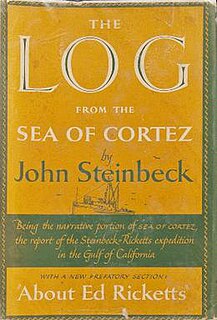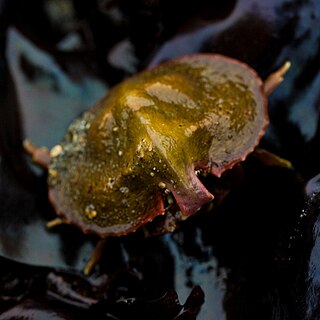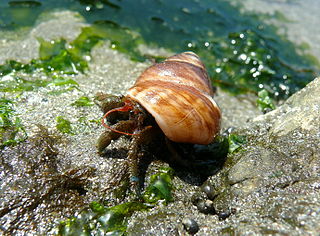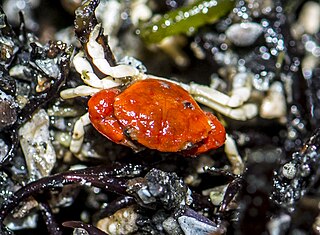
Edward Flanders Robb Ricketts commonly known as Ed Ricketts, was an American marine biologist, ecologist, and philosopher. He is best known for Between Pacific Tides (1939), a pioneering study of intertidal ecology. He is also known as a mentor that influenced the writer John Steinbeck, which resulted in a collaboration and coauthorship of the book, Sea of Cortez (1941). Eleven years later, and just 3 years after the death of Ed Ricketts, John Steinbeck reprinted the narrative portion of their coauthored book with a new publisher, but removed Ed as coauthor, while adding a biography of Ed Ricketts, and Steinbeck made a new title for the book as The Log from the Sea of Cortez (1951).

The gumboot chiton also known as the giant western fiery chiton, is the largest of the chitons, growing to 36 cm (14 in) and over 2 kg (4.4 lb). It is found along the shores of the northern Pacific Ocean from Central California to Alaska, across the Aleutian Islands to the Kamchatka Peninsula and south to Japan. It inhabits the lower intertidal and subtidal zones of rocky coastlines.

Intertidal ecology is the study of intertidal ecosystems, where organisms live between the low and high tide lines. At low tide, the intertidal is exposed whereas at high tide, the intertidal is underwater. Intertidal ecologists therefore study the interactions between intertidal organisms and their environment, as well as between different species of intertidal organisms within a particular intertidal community. The most important environmental and species interactions may vary based on the type of intertidal community being studied, the broadest of classifications being based on substrates—rocky shore and soft bottom communities.

The Log from the Sea of Cortez is an English-language book written by American author John Steinbeck and published in 1951. It details a six-week marine specimen-collecting boat expedition he made in 1940 at various sites in the Gulf of California, with his friend, the marine biologist Ed Ricketts. It is regarded as one of Steinbeck's most important works of non-fiction chiefly because of the involvement of Ricketts, who shaped Steinbeck's thinking and provided the prototype for many of the pivotal characters in his fiction, and the insights it gives into the philosophies of the two men.
Joel Walker Hedgpeth was a marine biologist, environmentalist and author. He was an expert on the marine arthropods known as sea spiders (Pycnogonida), and on the seashore plant and animal life of southern California. He was a spokesperson for care for the floral and faunal diversity of the California coastline.

Gnorimosphaeroma oregonense, the Oregon pill bug, is a small intertidal isopod crustacean. It is an oval-shaped organism roughly 6 mm in length, and about twice as long as it is wide. The primary habitat of G. oregonense is the mid-Californian to Alaskan coast, where it inhabits tidal pools and the intertidal region up to depths of 24 metres (79 ft).
Leptasterias pusilla is a small, six-rayed sea star.

Pacific Biological Laboratories, abbreviated PBL, was a biological supply house that sold preserved animals and prepared specimen microscope slides, many of which were of maritime aquatic species, to schools, museums, and research institutions. It was located in a building on what is now Monterey's Cannery Row on Monterey Bay in Monterey County, California.

Pagurus hirsutiusculus is a species of hermit crab, commonly called the hairy hermit crab. It lives from the Bering Strait south to California and Japan, from the intertidal zone to a depth of 110 m (360 ft).

Pisaster ochraceus, generally known as the purple sea star, ochre sea star, or ochre starfish, is a common starfish found among the waters of the Pacific Ocean. Identified as a keystone species, P. ochraceus is considered an important indicator for the health of the intertidal zone.

Cryptolithodes sitchensis, variously known as the umbrella crab, Sitka crab or turtle crab, is a species of lithodid crustacean native to coastal regions of the northeastern Pacific Ocean, ranging from Sitka, Alaska to Point Loma, California. Its carapace extends over its legs such that when it pulls in its legs, it resembles a small stone. It lives in rocky areas from the low intertidal to depths of 17 m (56 ft).

Edward F. Ricketts State Marine Conservation Area is one of four small marine protected areas located near the cities of Monterey and Pacific Grove, at the southern end of Monterey Bay on California’s central coast. The four areas together encompass 2.96 square miles (7.7 km2). Within SMCAs fishing and take of all living marine resources is prohibited except the recreational take of finfish by hook-and-line and the commercial take of giant and bull kelp under certain conditions.

Diodora aspera, also known as the rough keyhole limpet, is a species of sea snail, a marine gastropod mollusk in the family Fissurellidae, the keyhole limpets. Although similar in appearance to a common limpet, it has a hole near the apex of its shell, and is only distantly related. It often has a scaled polychaete worm Arctonoe vittata living inside its shell as a commensal. In the event that it is attacked by a starfish, it extends flaps of mantle to defend itself, and the worm also helps drive the predator away.

Hapalogaster cavicauda is a species of king crab that lives on the Pacific coast of North America.

Pagurus samuelis, the blueband hermit crab, is a species of hermit crab from the west coast of North America, and the most common hermit crab in California. It is a small species, with distinctive blue bands on its legs. It prefers to live in the shell of the black turban snail, and is a nocturnal scavenger of algae and carrion.
Emerita rathbunae is a species of "mole crabs" or "sand crabs" in the genus Emerita that lives along the tropical Pacific coasts of the Americas.

Myrtle Elizabeth Johnson was an American marine biologist, ascidiologist, and educator in California in the early 20th century. She was the first woman PhD faculty member at the San Diego State College and was chair of the Biology department for two decades. Her major work, Seashore Animals of the Pacific Coast, published in 1927, was the standard descriptive text of intertidal species until Ed Ricketts's Between Pacific Tides was published in 1939. Ricketts considered Johnson's book "the vade mecum of marine biologists of the Pacific."
Arctonoe vittata is a species of scaled polychaete worms commonly known as a "scale worm". This species often lives as a commensal of another marine animal.

Lophopanopeus bellus, the black-clawed crab, is a species of crab in the family Panopeidae. It is native to the Pacific coasts of North America, its range extending from Alaska to California.

Megalorchestia californiana is a species of sand-hopper in the family Talitridae. It was first described in 1851 by the German naturalist Johann Friedrich von Brandt and is the type species of the genus Megalorchestia. It is commonly known as the long-horned beach hopper.
















